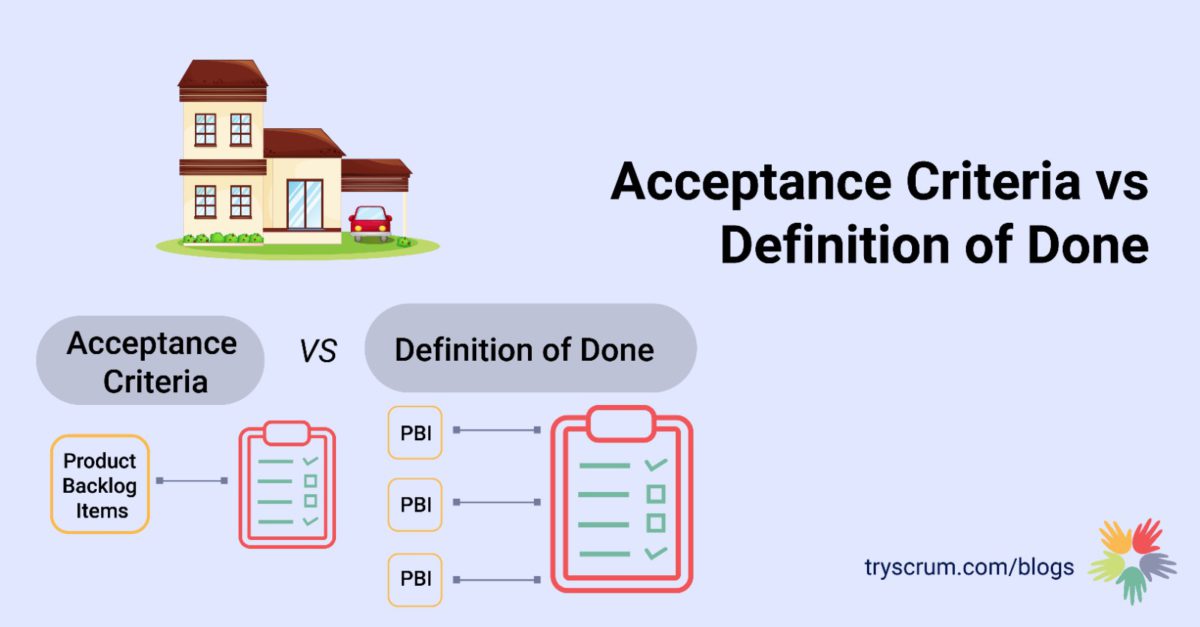Two terms often need clarification in the Agile Software Development approach: Acceptance Criteria and Definition of Done. These terms are critical to the success of any product development. Unfortunately, people often think Acceptance Criteria and Definition of Done are the same.
In this blog, we will illustrate the differences between Acceptance Criteria and the Definition of Done and explain why it is essential to understand both concepts. We will also provide examples of how they are used in software development and how Scrum teams can improve their Definition of Done over time.
Let us take building a home as an example.
Building a house can be arduous and complex, requiring careful planning and attention to detail. In software development, building a product is similarly complex and requires a clear understanding of both Acceptance Criteria and Definition of Done.
To better understand these concepts, let’s consider building a house. Each room in the house serves a unique purpose and has its own set of requirements or Acceptance Criteria.
For example, the kitchen may require specific appliances and finishes, while the bathroom may require specific plumbing and tile work. In addition, the living room may need distinctive furniture, flooring, and lighting to meet its functional requirements.
Similarly, in software development, each feature or Product Backlog item has its own set of Acceptance Criteria that must be met to ensure it meets the functional requirements. These may include specific user flows, data inputs, or outputs.
However, just as a house requires more than individual rooms, a software product requires more than individual features. Overall conditions must be met to consider a home complete, similar to the Definition of Done in product development.
For instance, a Definition of Done for a house may include requirements such as:
- All rooms need to be painted and varnished
- No leaks in any of the rooms
- Weather coating must be done
- All finishing work must be complete, including trimming, fixtures, and cabinetry.
Similarly, a Definition of Done in software development may include requirements such as:
- All code must be peer-reviewed
- All automated tests must pass
- All code must pass security tests
- All code must follow coding standards.
Creating a Definition of Done can be challenging, but a few key approaches can help.
- One approach is collaborating with stakeholders to identify their specific requirements and expectations. Then, co-creating the definition of DONE
- Another approach is to review industry good practices and standards, such as those recommended by the Scrum framework or other agile methods. It is also essential to revisit the Definition of Done periodically and adjust it to reflect changes in the product, team, or stakeholder requirements.
While it can be time-consuming and require much work, the Definition of Done can help the team ensure quality standards are met before claiming a Product Backlog item. This helps the team forecast better to pull product backlog items. Acceptance Criteria can help the teams do the right, and the Definition of DONE can help the teams do things right.
A product can be considered complete and ready for deployment by meeting these conditions. Like building a house, it is essential to clearly understand both the Acceptance Criteria and Definition of Done in software development to ensure a high-quality final product.
In conclusion, building a house and software products require careful planning and attention to detail. Just as a house has individual rooms with unique requirements and an overall Definition of Done, a software product has individual features with its own Acceptance Criteria and an overall Definition of Done. By understanding and implementing both, Scrum teams can ensure they deliver high-quality products that meet the expectations of their stakeholders and gain customer trust.




Leave a Reply